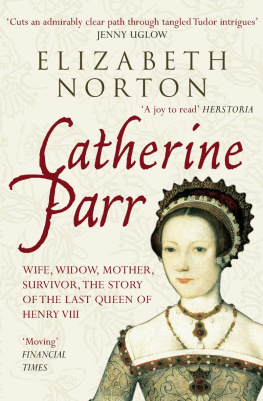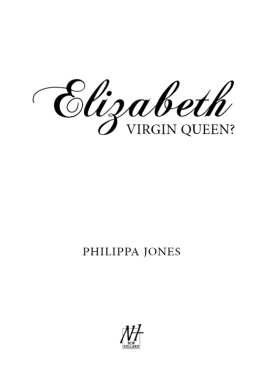
www.headofzeus.com
To read this book as the author intended and for a fuller reading experience turn on original or publishers font in your text display options.
To David, Dominic and Barnaby
CONTENTS
6 FEBRUARY 1559
The great gallery at Whitehall, though capacious, was crowded that afternoon as the Council and a deputation of thirty members of the House of Commons filed in, following their Speaker. The woman who was the focus of their attention seemed slight beneath her canopy of estate, facing the clamorous throng. Gorgeously dressed, in clothes from a wardrobe that included fine satins and velvets, and cloth of gold and silk, Elizabeth had been proclaimed queen only three months before. Now she sat, pale-faced, upon the throne that had once been her fathers. Her long yellow-red hair was pinned up, away from her face. She wanted the world to see her as they had done her father stern-faced, but also serene and majestic. Yet she was still young only twenty-five. She was also unmarried, which, in a queen, was an aberration.
Elizabeth called her first Parliament on 25 January 1559, not long after her coronation. The Commons and Lords considered the nature of the religious settlement that would replace the Catholicism reintroduced in Queen Marys regime and other pressing matters besides; but thoughts also turned to the question of who should take the crown matrimonial and become king. It was unthinkable that the queen should not soon marry. Already, offers were being made, both at home and abroad. Voices in the Commons proved the boldest in raising the issue, and on 4 February 1559 they petitioned for an audience with the queen. It was granted two days later.
Now, as a hush fell over the room, Sir Thomas Gargrave, Speaker of the Commons, stepped forward. He was nearly forty years older than his monarch, a blunt Yorkshireman with thin lips and a serious face which tapered almost to a point at his chin. With considerable Parliamentary experience behind him, it must have seemed a simple matter to come before this inexperienced young woman. But her dark, intelligent eyes scrutinized him keenly from the dais. As he began to read his prepared speech, his monarchs gaze made him fear the unworthiness of every word which he was about to present to her ears. He stumbled over his lines. He stuttered out a request to the queen to marry, as well for her own comfort and contentment, as for assurance to the realm by her royal issue.
There was silence as the queen considered his words. Then, with a princely countenance of voice and a sudden, quick gesture of her hand, as though she was surprised, she answered. She gave them great thanks, she said, for the love and care which they did express, as well towards her person as the whole state of the realm. She liked the petition and took it in good part, as she assured the Commons, who must have breathed a communal sigh of relief. If it had been otherwise, she continued, if you had taken upon you to confine, or rather to bind, my choice; to draw my love to your liking; to frame my affection according to your fantasies; I must have disliked it very much. It was for them to obey her, not her to obey them.
Elizabeth then turned her attention to the matter of their suit. Ever since she had reached her years of understanding, being (as she said) first able to take consideration of myself, she had made a decision. Matrimony was not for her. She had, she said, made choice of a single life, which hath best, I assure you, contented me, and, I trust, hath been most acceptable to God. She meant, she assured them, to preserve in a virgins state.
Elizabeths words probably seemed fanciful to those assembled. Nobody believed that a queen could hope to reign alone. It was, those who were present must have reasoned, inconceivable that she would not marry and provide England with an heir. Indeed, the queen was already showing her interest in men, for was not her handsome Master of Horse, Robert Dudley, often by her side at court?
As she made her answer, Elizabeth told the Commons that as for me, it shall be sufficient that a marble stone shall declare that a queen, having lived and reigned so many years, died a virgin. She claimed that, since her youth, she had always continued in this determination, but there were those standing by, including her chief gentlewoman of the bedchamber Kate Ashley, who might have disagreed.
Once, her virginity had not been so jealously guarded. Ten years ago to the day, as a fifteen-year-old, she had been closely questioned on her attempts to take a husband of her own choosing, who was already known to have visited her bed. When she was a teenager, there was one man who had caught her fancy enough to tempt her to abandon herself to him.
The Virgin Queen was born out of the ashes of his fall.
The Seeds of Scandal
Sir Thomas Seymour, second in command of Henry VIIIs invasion force in France, surveyed his troops. He was not a man of half measures. He entered into everything with gusto and determination, but not always skill or foresight. Everyone liked him, even the rapidly ageing king who, by this year of 1543, was a gross caricature of his former self, yet in his decrepitude still longed to conquer France.
That July, Seymour began burning and taking French castles as a prelude to the main invasion, which was scheduled for the following year. As cannons smoked and men charged into French territory, the thirty-five-year-old commander had finally been given the chance to begin satisfying his overweening ambition.
Pale-faced, but certainly not unpleasing, Thomas Seymour resembled his younger sister Jane, the sibling to whom he was closest in age. The road to France, and to military glory, had started with her only a few years before. It had begun with a birth.

AFFECTION SHALL LEAD ME TO COURT
It was bracingly cold in London on the morning of 11 October 1537. The weather the previous year had been so piercing that the Thames had frozen, forcing water traffic onto the already crowded streets of Englands capital. This year would not prove so frigid, but at this time of day, as the sun slowly began to rise, the assembled crowds still had their hands tucked away against the frost, and there was a murmur in the air. They were waiting for news but as yet, there was none to report.
The friars, priests and clerks gathered there pulled on their ceremonial copes, which appeared vivid against the monochrome-looking buildings. The mayor and aldermen of the city, along with members of all the crafts guilds in their liveries, joined them, forming into a line. It was a companionable scene, since such gatherings were frequent enough for the participants to know each other well; but that day they walked with downcast eyes. Slowly, they processed through the narrow, tunnel-like streets of the city, passing ancient buildings of timber or stone, their feet pressing on the rutted, cobbled streets. Prayers were on the lips of the priests. Crowds watching from the streets or from jettied windows above adopted the invocation. It was a prayer for the queen, Jane Seymour, who had already been in labour for a day and two nights. All Englands hopes rested on her good hour.






















